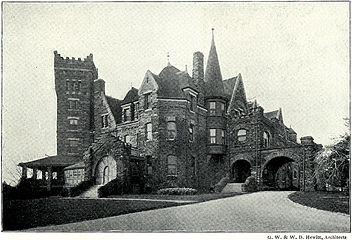
Germantown is an area in Northwest Philadelphia. Founded by German, Quaker, and Mennonite families in 1683 as an independent borough, it was absorbed into Philadelphia in 1854. The area, which is about six miles northwest from the city center, now consists of two neighborhoods: 'Germantown' and 'East Germantown'.

Chestnut Hill is a neighborhood in the Northwest Philadelphia section of the United States city of Philadelphia, Pennsylvania. It is known for the high incomes of its residents and high real estate values, as well as its private schools.

Manayunk is a neighborhood in the section of Lower Northwest Philadelphia in the state of Pennsylvania. Located adjacent to the neighborhoods of Roxborough and Wissahickon and also on the banks of the Schuylkill River, Manayunk contains the first canal begun in the United States. The area's name is derived from the language of the Lenape Indians. In 1686-dated papers between William Penn and the Lenape, the Lenape referred to the Schuylkill River as "Manaiung", their word for "river", which literally translates as "place to drink"; the word was later altered and adopted as the town's name.

Mount Airy is a neighborhood of Northwest Philadelphia in the U.S. state of Pennsylvania.

Tulpehocken station is a SEPTA Regional Rail station in Philadelphia, Pennsylvania. Located at 333 West Tulpehocken Street in the Germantown neighborhood, it serves the Chestnut Hill West Line. The Pennsylvania Railroad built the station in 1878. The station is in zone 2 on the Chestnut Hill West Line, and is 8.5 track miles from Suburban Station. In 2004, this station saw 176 boardings on an average weekday.

This is a list of the National Register of Historic Places listings in Philadelphia, Pennsylvania. There are more than 500 properties and districts listed on the National Register in Philadelphia, including 67 National Historic Landmarks.
Andorra is a neighborhood in Northwest Philadelphia, which is a section of the city of Philadelphia, Pennsylvania. Andorra is a part of Roxborough, being within the borders of the original Roxborough Township and having the same zip code (19128). At some point during the 19th or 20th century, Andorra developed a cultural identity as a neighborhood within Roxborough. Andorra was named "Andorra" after a fancied resemblance to the small country of the same name which sits astride the Pyrenees between France and Spain.

Henry H. Houston was a leading Philadelphia businessman and philanthropist. He worked in iron and transportation industries and invested in oil and precious metal concerns. He sat on boards of a number of railroad organizations and he was trustee of the University of Pennsylvania and Washington and Lee University. He developed Wissahickon Heights, an exclusive community in western Chestnut Hill.

G. W. & W. D. Hewitt was a prominent architectural firm in the eastern United States at the turn of the twentieth century. It was founded in Philadelphia in 1878, by brothers George Wattson Hewitt (1841–1916) and William Dempster Hewitt (1847–1924), both members of the American Institute of Architects. The firm specialized in churches, hotels and palatial residences, especially crenelated mansions such as Maybrook (1881), Druim Moir (1885–86) and Boldt Castle (1900–04). The last was built for George C. Boldt, owner of Philadelphia's Bellevue-Stratford Hotel (1902–04), G.W. & W.D. Hewitt's most well-known building.

Houston Hall is the student union of the University of Pennsylvania, in Philadelphia, Pennsylvania. Completed in 1896, it was the first student union built on an American college campus.

The Anglecot, also known as the Potter Residence, is a historic residence in the Chestnut Hill neighborhood of Philadelphia, Pennsylvania, United States. It was designed by noted Philadelphia architect Wilson Eyre for Charles Adams Potter (1860-1925), a manufacturer of linoleum.

The Thomas Mill Covered Bridge, aka the Thomas Mill Bridge or the Thomas Mill Road Covered Bridge, is a historic, single-span, wooden covered bridge across the Wissahickon Creek in Fairmount Park in Philadelphia, Pennsylvania.

Wissahickon is a neighborhood in the section of Lower Northwest Philadelphia in the state of Pennsylvania. Wissahickon is located adjacent to the neighborhoods of Roxborough and Manayunk, and it is bounded by the Wissahickon Valley Park, Ridge Avenue, Hermit Street, and Henry Avenue. The name of the neighborhood comes from the Lenni Lenape word wisameckham, for "catfish creek", a reference to the fish that were once plentiful in the Wissahickon Creek.

The Chestnut Hill Historic District is a historic area covering all the Chestnut Hill section of Philadelphia, Pennsylvania.

The Ebenezer Maxwell House, operated today as the Ebenezer Maxwell Mansion, is an historic house located in the West Germantown neighborhood of Philadelphia, Pennsylvania.

The Concord School House is a historic one-room schoolhouse in the Germantown section of Philadelphia, Pennsylvania. It is operated today as a museum. It is part of the Colonial Germantown Historic District which was named a National Historic Landmark District in 1965.

Edmund Beaman Gilchrist was an American architect, best remembered for his English-Cotswold and French-Norman suburban houses.
Robert Rhodes McGoodwin was an American architect and educator, best known for his suburban houses in the Chestnut Hill and Mount Airy sections of Philadelphia, Pennsylvania. He taught at University of Pennsylvania from 1910 to 1924, and served as a trustee of its School of Fine Arts from 1925 to 1959. McGoodwin was active in the Philadelphia Chapter of the American Institute of Architects, serving as its president in 1943.

Mellor, Meigs & Howe (1916–28) was a Philadelphia architectural firm best remembered for its Neo-Norman residential designs.

Oaks Cloister, is the name of the former residence of architect, Joseph Miller Huston. Constructed in 1900, the mansion is located at 5829 Wissahickon Ave Philadelphia, PA 19141 in the Germantown section of Philadelphia, PA, and was the home and studio of Philadelphia born, Joseph Huston (1866-1940), architect of the PA Capitol. The Tudor style home incorporates architectural elements and work by many capital artists. Oaks Cloister was fully restored to its original glory in 2012, and was listed on the National Register of Historic Places in 2019.

























